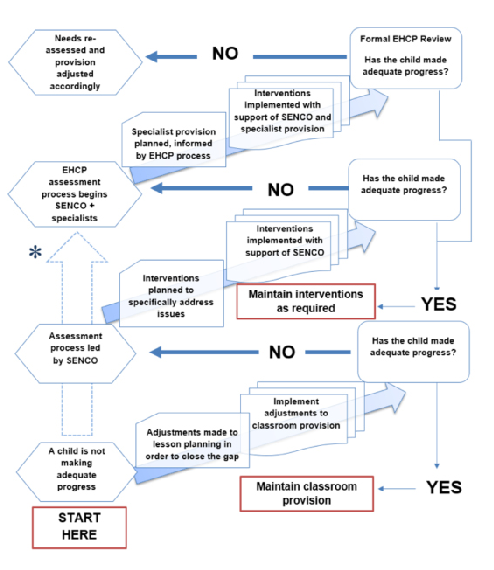
The Code of Practice is clear - all teaching should be high quality, with careful monitoring of progress and carefully planned interventions. When this is in place, identification of any learning needs will be more efficient. Early identification and early action is vital to prevent any further delay in the child making progress.
Settings should use the 4-stage graduated approach - assess, plan, do and review, with evidence of progress used to inform next steps. This evidence trail is important when/if an Education Health Care Plan (EHC Plan) process formally begins.
When a setting makes special educational provision for a child with SEN, a maintained nursery must inform the parents, other settings should inform the parents. This process is led and co-ordinated by the SENCO who supports practitioners. The principles of early support do enable a fast track process of serious concerns regarding special needs to be noted. The following diagram outlines the graduated response in practice:

CHILD FILE 1:
KEY
The dotted blue arrow indicates fast track early intervention if needs are significant.

Figure 1.1: The Graduated Flowchart
The ‘structured conversation’ model employed in the Achievement Early programme has been particularly effective in enabling parents to engage with their children’s learning and practitioners/settings to get to know the children better. The structured conversation provides space and time for parents to talk to the practitioner or teacher (and if appropriate their child) about their child, his/her learning, strengths, weaknesses and aspirations.
For some children interventions may better support their learning and development. These can be put in place as appropriate. They should be regularly monitored in the context of the child’s progress. If the child is not making expected progress with a particular intervention, practitioners should consider what else may be needed. It may mean changing the intervention or it may mean moving towards a formal needs assessment, the next step in EHC Plan process.
| Discussion point |
| Reflect on what you have just read in relation to enabling children who have or may have an SEN. Consider the graduated response flowchart. Focus (mentally) on 3-4 children in your setting and consider what you are doing to support their learning. Follow through the flow chart. What could you do better? How could you make better provision for children who have or may have a SEN? |
(Adapted from Blandford and Knowles. (2016). (2nd ed.) Developing Professional Practice 7, Abingdon: Routledge)